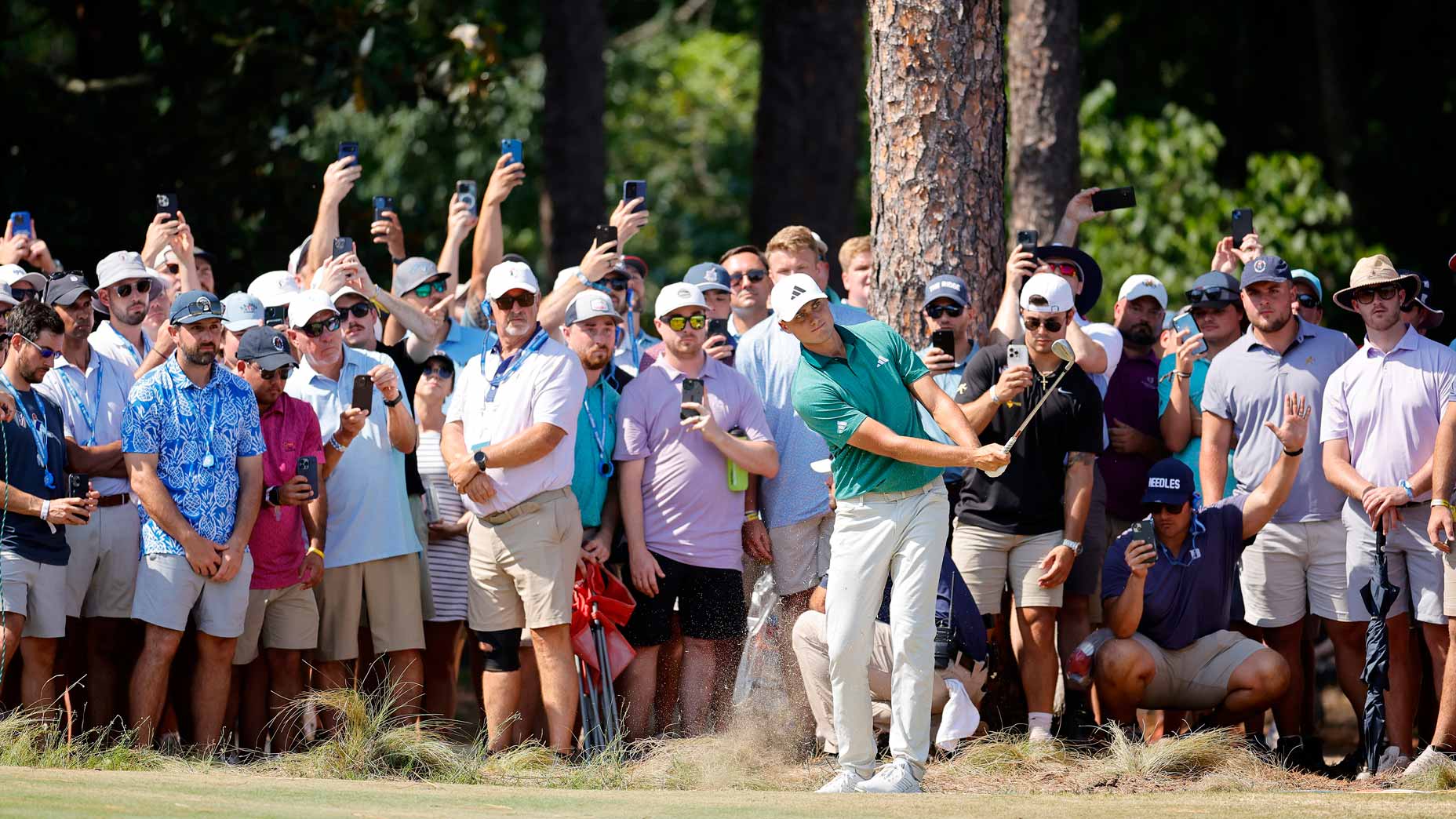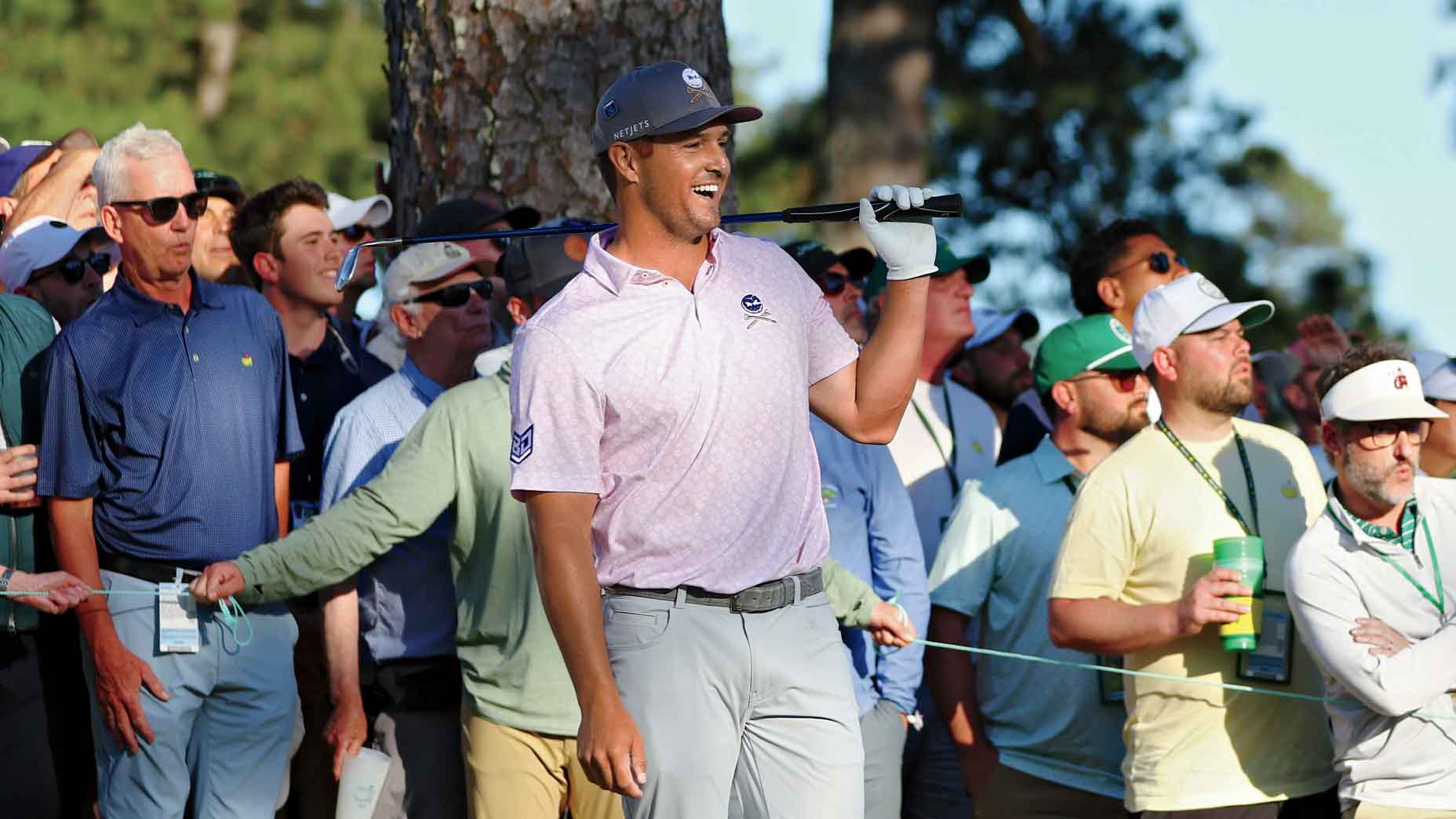Golf’s post-money generation is here, and they’re terrifying

Ludvig Aberg, Tom Kim, Nick Dunlap, Austin Eckroat and Nicolai Hojgaard represent a chunk of the impressive next generation of golf superstars.
Getty Images/Photo Illustration
The PGA Tour has always had its share of phenoms. Think Jack, Jordan, Tiger, Rory. But in an era of ultra-high-tech learning, hyper fitness and, yes, LIV defections, the trend of young guns racking up Tour titles is peaking. Welcome to … Gen Next on the PGA Tour.
IF MONEY IS THE MOST ubiquitous thing in pro golf, then money games are a close second.
Walk around a Tour stop during any early-week practice round and you’ll find yourself besieged by them — big-money matches, skins games, $10 “dots,” $50 “hammers.” The friends play for a lot; the acquaintances play for a little. But everybody plays for something. Even the guys playing alone. Like Tom Kim, who’s meandering up the 18th fairway at TPC Sawgrass on Players Championship Monday with a sort of convivial swagger and a modest audience of three—his caddie and your correspondent included.
Kim, stocky and a mere 21 years old, is one of golf’s most popular young stars in part because of that impish bravado. As a 20-year-old member of the International squad at the 2022 Presidents Cup, Kim and his penchant for fist pumps earned raised eyebrows from a heavily favored Team U.S.A. But his knack for unseating Americans expected to mop the floor with him quickly alerted the golf world to the fact that the South Korea–born killer was not like the 20-year-old golfers who came before him. Not even close.
“He has the ability to be a global superstar,” Kim’s captain, Trevor Immelman, said then. “I’m a huge, huge fan.”
Two years, a Nike sponsorship, a Netflix Full Swing spotlight and a trio of PGA Tour wins later, Kim is every bit a global superstar—and he’s yapping at his new caddie, Paul Tesori, like every bit the overgrown kid he is. Tesori, fortunately, is pretty much Old Yeller, a patient looper whose patchy white beard and mahogany tan are remnants of a few decades on Webb Simpson’s bag. Which makes Kim — loud and stout, with a powerful build and beefy calves — a bulldog. Or perhaps a pesky corgi.
“Come on!” says Kim, goading his caddie. “You know you want to make it an even $100.”
The two are in the final stages of a solo $10 skins game. For every birdie Kim makes, Tesori forks over a ten-spot; for every bogey Kim posts, he owes Tesori a tenner. Standing in the 18th fairway, the golfer, who turned pro at age 16, is up $60. But now, staring down his approach on Sawgrass’ scary-difficult par-4 finisher, he’s getting greedy.
“Fine,” says Tesori, surrendering to the relentless needling. “We’ll do $100.”
“Oh, man,” Kim says with a devilish grin as he stripes a gorgeous iron shot that splits the center of the green, setting up a 25-foot birdie look. “You shouldn’t have said that.”

MONEY ISN’T WHAT DRIVES TOM KIM. If it were, he’d have taken a truckload from LIV in the league’s earliest days.
At the time, Kim was an Order of Merit winner on the Asian Tour and LIV had just secured control of that tour with a $300 million investment. Kim was there, sitting next to Greg Norman, when the deal was consummated. By accepting LIV’s money, Kim could have stayed close to home, played often in Asia and served as an emissary for the global growth of golf that, early on, was said to be central to LIV’s ambitions.
But what Kim longed for was a different playing opportunity. The raft of veterans who exited the PGA Tour’s upper ranks for LIV money had cleared the way for an influx of new talent. Sensing LIV’s threat, the Tour expanded its eligibility requirements and opened pathways to membership for players from around the world.
Kim, then barely older than a teenager, heard the call. He wasn’t alone. As it turned out, close to a half dozen hopefuls had similarly trained their attention on the PGA Tour, and in the two years since LIV’s crash landing into golf, this Great Youth Wave has washed over the sport with force — PGA Tour victories, Ryder Cup heroics, major championship moments. This group is younger, more diverse, more distinct and, arguably, more talented than any that has entered pro golf before it. Spend enough time around them and you’ll start to wonder if the Great Youth Wave is this good because of their differences.
Take, for example, the Nordic pairing of Ludvig Aberg and Nicolai Hojgaard. Aberg, a phenom as a teen in his native Sweden, immigrated to the States in 2019, where he played four years at Texas Tech and became among the most decorated collegiate golfers of this millennium. Denmark’s Hojgaard took the opposite tack, playing for years on the Danish Development Team with his twin brother Rasmus before advancing through the ranks on the DP World Tour.
When the PGA Tour came calling for both players in 2023, Hojgaard, now 23, and Aberg, 24, arrived like thunder and lightning, displaying a dizzying yet deeply contrasting array of skill. Aberg’s success came by virtue of his cyborg-like demeanor and terrifyingly towering ballflight — a 6-iron-wielding Terminator; Hojgaard’s came thanks to a healthy sense of youthful indignance and an artist’s flair for the dramatic — think John Lennon in a polo shirt. Both were selected to compete at the Ryder Cup last year in Rome, where they starred for the Euros in their blowout win. In the span of just 12 months, some of America’s fieriest team players had been vanquished — first at the Presidents Cup (despite Team Euro’s loss), then at Marco Simone — by a trio of unique international up-and-comers united by a lone common struggle: the ability to grow facial hair. We kid, but…

“It’s quite surreal,” admits Aberg with an uncharacteristically sheepish smile. He’s among a number of newbies who’ve gathered early Wednesday morning for the “first-timers” press conference at the Players. “I mean, it wasn’t that long ago that I was watching on TV and cheering [these Tour players] on. Now, I’m actually trying to beat them.”
And succeeding. Four months after turning pro in June 2023, Aberg was a runner-up finisher at the Sanderson Farms Championship. Six weeks later, he notched his first Tour win at the RSM Classic. At the time of the Players he was, stunningly, already the ninth-ranked golfer in the world.
In 2024, young bloods continue on a tear. At the American Express in January, 20-year-old Nick Dunlap became the first amateur to win a PGA Tour event in 33 years, reaching a milestone last touched by Phil Mickelson. In March, at the Cognizant Classic, 25-year-old Oklahoma native and former OSU All-American Austin Eckroat held off a field featuring major champs Rory McIlroy and Shane Lowry to take the top prize.

The point isn’t that success has come uncommonly early for these guys — plenty of young golfers have done that in generations past, from Nicklaus and Palmer to Woods, Spieth and McIlroy. It’s that no generation has ever seen quite this much talent emerge quite so explosively, which raises the question: Why?
No doubt, the LIV defections of the past few years have cleared PGA Tour leaderboards of some formidable talent: Rahm, Koepka, Joaquin Niemann, Cam Smith. As Tour commissioner Jay Monahan noted the week of the Players, in mid-March of 2023 the median Official World Golf Ranking of Tour winners early in that season was 16. This season in mid-March, the median rank of winners was 67 (a number that dropped significantly after World No. 1 Scottie Scheffler posted back-to-back wins at the Palmer and the Players).
Still, for decades the game’s top golfers have been steadily getting younger. In 2000, arguably Tiger Woods’ most dominant season, the then 24-year-old had nine Tour wins. The average age of a Tour winner that same year was 32.19. By the 2014-15 season, when 21-year-old Jordan Spieth was virtually a one-man youth-quake, the average age of a Tour winner had dropped to 30.54, a number that might nearly have dipped below 30 had 51-year-old winner Davis Love III sat out the Wyndham Championship that year. This season, through the Players in mid-March, the number was at 30.78.
Theories abound about the youth movement. The best of them relate to how well prepared these young studs are. Collegiate golf, more competitive than ever, now functions almost as a mini tour. Technology has made upstart golfers savvier and their swings far more technically sound. The focus on fitness is at an all-time high.

But luck is still a factor too.
“I think I just got hot on the right week,” Dunlap says a little shyly. “I think winning at AmEx was a blessing and also … a bad thing for me. It raised my level of expectation to the highest place, which has been tough. The competition is definitely higher out here than what I’m used to.”
Dunlap’s explanation suggests that his expectations weren’t sky-high to begin with. His status as the only golfer other than Woods to win both the U.S. Junior Amateur (in 2021) and U.S. Amateur (2023) makes that a little hard to believe.
Paradoxically, uncomfortably high expectations might be the driver of this youth revolution. In a talent pool wider and deeper than ever, is it possible these kids are punching up just a little more fiercely than the phenoms who came before them? And where, in a sport on the bleeding edge of innovation, is there any room to punch? Perhaps it’s the one aspect of the game where physical skill means little.
It’s quite surreal,” admits Aberg. “I mean, it wasn’t that long ago that I was watching on TV and cheering [these Tour players] on. Now, I’m actually trying to beat them.”
“These young guys are just very mature,” says Joe Skovron, the longtime caddie to Rickie Fowler who, recently, briefly looped for Kim before moving to Aberg’s bag full time. “It shows in their keeping calm in all situations — not getting dragged away, having a good perspective on the game, a good perspective when something goes wrong. They’ve got a steady hand.”
Skovron’s point was repeated in so many words by every young player interviewed for this piece. The differentiator for them, they say, is not the ability to hit the ball farther or work out harder but in their capacity to handle the mental game.
“My demeanor is the most consistent thing,” says Eckroat. “My ball striking will come and go, but I can always maintain the same headspace.”
Aberg agrees: “I think I’m pretty good at separating the game from the other stuff.”
“Rasmus and I, we never really had been in a situation where we felt like we needed anyone to help us,” says Nicolai Hojgaard about himself and his pro-golfer bro. “There was always competition, and no matter what we did — it could be grades in school, it could be racing to the car — we were always trying to get an edge.”
This, it seems, is the throughline for golf’s Great Youth Wave. Or at least the 2024 version of it. They’ve chosen the PGA Tour not specifically for money, but because they couldn’t imagine competing anywhere else. If the generation before them aspired to emulate Tiger’s bulk, body and length, this generation aspires to clone his brain.
“Everyone can hit the ball close and can putt it and chip it,” says Kim, the owner already of 12 global pro wins. “The difference is that here, everyone’s so locked in. In the past, guys were able to get away with not being as sharp mentally. Now, even if you go into Sunday holding a three-shot lead, you’ve got to go out and shoot 67. You realize you can make a huge difference by winning mentally.”
Another way to put it — which, in a time of painful obsession over money in the sport, might be a bit strange in thought — is that these guys are in it less for the dough than for the competition and the stakes.
How radical is that?

BACK ON THE 18TH GREEN, the low-budget, practice-round money game has gotten very real for Tom Kim. A hundred bucks and bragging rights are on the line.
Caddies will tell you they learn the most about their player in these moments, which is why they so often entertain bets with their millionaire partners even when their own salaries resemble something closer to a middle manager at an insurance brokerage. Seeing your guy make a $50 birdie doesn’t guarantee he’ll drain a $5 million putt. But seeing how he handles the pressure is telling.
“Paul has worked in pro golf for 30 years,” Kim says. “He knows the things that work and the things that don’t.”
To this end, Kim’s round has already been revealing. Asked on a prior tee box about his own differentiating factor, he slows his roll to think.
“What have the other guys been telling you?” he asks. I tell him that no one’s taken this long to answer. He grins.
“I’m good at staying within my own,” he finally says. “I don’t chase things.”
On the 18th green, Kim’s self-counsel comes to life. He isn’t chasing a birdie; he’s stalking it. He prowls the hole quietly, holding a careful gaze at the base of the flagstick. His focus lengthens.
The putt is a prayer down a wicked-fast slope and across a ridge, and Tesori is laughing as Kim strikes it. But then it’s tracking … and tracking … and Tesori’s laughter is growing louder … and Kim is following it to the hole like he already knows what’s going to happen next. And that’s the funny part: He does.
We all do.
You can reach the author at james.colgan@golf.com.










